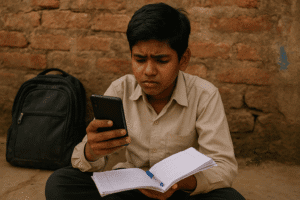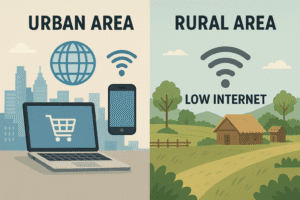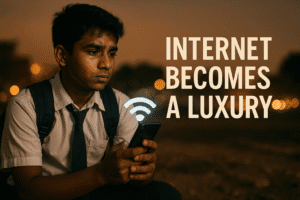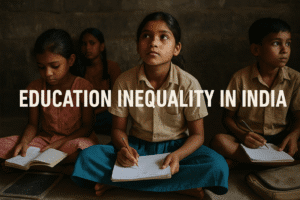 The Other India That Never Logged In
The Other India That Never Logged In
At eight o’clock in the morning, she puts on the pressed school uniform. Not because she has a class to attend, but because that’s the only portion of her life that still feels remotely systematic. She takes slow walks carrying her father’s old pink smartphone to the top of a small hill near her home in rural Bihar. The signal is weak, and the internet is almost nonexistent at home. Unfortunately, her class will only load for long periods and never actually work. Yet, she still ascends.
Aarav logs in from his air-conditioned bedroom in Delhi while sitting comfortably hundreds of miles away. He has access to a stable broadband connection, a personal laptop, and an HD webcam. His learning never halted during the pandemic; in fact, he’s ahead of the syllabus. Two Indian children. Two different realities. Same age. Same grade. This is India’s digital divide—a problem that many people don’t talk about. This problem is gradually pushing millions of students out of the education system. In this article, we will unpack this issue.
🧱 The Digital Divide in India – A Wall You Can’t See but Can’t Cross Either
The digital divide in India isn’t so much a question of does one has a device. It’s whether they have access to opportunity. Based on 2024 statistics from the Telecom Regulatory Authority of India (TRAI) and National Sample Survey estimates, as few as 31% of Indian homes are connected to reliable internet. That figure falls to a mere 18% in rural India, even with ongoing efforts under the Bharat Net project. Even in 2025, there are still numerous families who own smartphones and share one phone among multiple children, and often among adults who must use it as well for professional purposes.
This intangible wall—constructed not of bricks, but of bandwidth and affordability—is what demarcates the future-ready from the future-lost.
 Here’s a graphical illustration of internet access in Indian homes as of 2025:
Here’s a graphical illustration of internet access in Indian homes as of 2025:
● 31% of all the households are internet-enabled.
● 18% of the rural households are internet-enabled.
● 52% of the urban households are internet-enabled.
🚫 Online Education in India – A Privilege, Not a Right

The purpose of the online education system in India was to provide equal opportunities for all. Unfortunately, it did the opposite. In well-to-do urban households, digital learning translates to uninterrupted classes, a reliable internet connection, and on-demand assistance. Unfortunately, education simply ceased for millions in low-income and rural areas. While a student in Delhi may have a laptop, attend Zoom lectures, and receive homework assistance from private tutors, a child from rural Odisha shares a phone with his/her siblings, has limited network coverage, and receives disorganized worksheets that their illiterate parents are unable to explain.
Even in urban areas, class plays a role. Slum children regularly missed whole school years, not out of lack of desire, but out of lack of opportunity. The reality is brutal: online education in India is rigged in favor of the privileged. And
while some students march forward with technology-facilitated learning, others are left behind—hidden, unheard, and unaided. Education is meant to be a right. But in e-digital India, it’s becoming a luxury.
💸 WiFi for Students – When Internet Becomes a Luxury
 For most Indian households, WiFi for students is not a necessity—it’s a pricey fantasy. Middle-class families feel the strain too, balancing EMIs and vegetables while attempting to pay for monthly data plans.
For most Indian households, WiFi for students is not a necessity—it’s a pricey fantasy. Middle-class families feel the strain too, balancing EMIs and vegetables while attempting to pay for monthly data plans.
Three siblings living in the same flat in Mumbai share their mother’s phone to attend online classes. In Lucknow, a boy climbs on the rooftop of his building every day to “borrow” WiFi from a shop’s weak signal. A girl from Chennai missed her board exam because her phone died, and there was no power to charge it.
Each one of us has a story of stress, sacrifice, and a fight behind every screen. In a society that presumes every pupil is just a click away, in reality, many are still on a chase for that single stable connection.
⚖️ Education Inequality in India – Who’s Left Behind, and Why It Matters
 Indian education inequality isn’t rich vs. poor—it’s who gets a future, and who quietly gets forgotten.
Indian education inequality isn’t rich vs. poor—it’s who gets a future, and who quietly gets forgotten.
As schools transitioned to virtual learning, countless children disappeared from the educational framework, not due to a deficiency of ability, but a deficiency of the necessary resources. In rural Maharashtra, community worker Sita Devi states, “We had one village
where over 30 girls were lost to child marriage during the school lockdowns. They never returned.”
The dropout rate surged. Students’ learning gaps increased. For many kids, “school work” meant taking care of the house, babysitting, or working jobs. As per ASER 2025, over 61% of children in rural regions were unable to read even at a basic level after two years of disrupted schooling.
This is not a short-term fall; it is the arrival of a crisis that may stretch across generations. It’s the kind of scenario where today’s abandoned lessons become lost opportunities later on.
Let’s stop pretending this is an issue only for “rural” areas. Even in cities, students without internet access are failing in India.
In urban slums, an entire group of children struggles to work with a single smartphone with poor connectivity. Lack of a quiet private room, a desk, or adult supervision makes homework unachievable. Learning is a fractured jigsaw puzzle buried in non-educational turmoil like noise, work, or the constant battle to simply survive.
Meena, aged 12, hails from a village in Uttar Pradesh. She only has access to a broken smartphone with her three siblings. To get a signal, she has to walk two kilometers to a railway line. Her class interactions last for five minutes, but only to buffer for the rest. “I’ll pretend I know what they’re talking about,” she explains. “I don’t want them to feel bad knowing that I have to miss out on everything.”
This disconnection doesn’t just hurt academics—it chips away at confidence, mental health, and self-worth.
Think of the pressure this puts on kids. They are taught to think that education alone can uplift them from the shackles of poverty. Yet, they see better-off peers scrolling through their devices while they wait, both literally and figuratively, for a sign to get things going.
🏙 Rural vs Urban Internet Access in India – Where You’re Born Decides What You Learn
If there’s one harsh reality about contemporary India, it is this: your postal code decides
your destiny.
Whereas urban areas get to experience fiber-optic broadband, small towns are still trying to figure out how to keep the electricity on regularly. The disparity in rural versus urban internet access in India isn’t merely one of speed—it’s one of presence or absence.
In Delhi, 13-year-old Vihaan learns coding on a laptop in his room. His homework is typed, and his classes are uninterrupted. Meanwhile, Anjali, who lives in rural Jharkhand, is also 13, and walks five kilometers uphill every day—not to go to school, but to catch a faint mobile signal that allows her to download a lesson’s PDF. This is not just a gap—it’s a digital chasm.
📉 The Hidden Challenges of Online Learning No One Talks About
Online learning vowed continuity—but for Indian students numbering in the millions, it brought chaos, confusion, and silent anguish. This is what they don’t tell you:
● 📱One Device, Many Needs: One of the most impactful barriers in technology integration is the device ownership. In many homes, one smartphone is split between siblings, or even parents who are currently working from home. Class time turns into an argument rather than a timetable.
● 🚫No Personal Connection: Many students feel as though they are invisible when the screen is off and the microphone is muted. The connection of the educator with a learner slowly diminishes and makes children feel unenthusiastic and neglected.
● 🧠Mental Health Strain: No playmates. No recess. Just a screen. Children miss interaction, humor, even schoolyard fights. It’s not loneliness—it’s emotional isolation
● 😔Digital Fatigue Is Real: Looking at a screen for 6 hours or more saps one of their energy. Routine headaches, back pain, and irritability become the new norm.
● 🧪Exam Anxiety Without Support: Students are required to show evidence of participation in online assessments, but there is little interaction to go over what has been done and what requires further explanation, so tension mounts in the absence of doubt-clearing and feedback.
Behind every “logged-in” student is a child trying to learn in a world that wasn’t built for them. And we’re not talking about it nearly enough.
🌱Solutions That Can Actually Bridge the Digital Divide
The digital divide in India isn’t just a tragedy. It’s a solvable crisis. Here are six powerful, real-world solutions that could actually change the game:
● 📡Community WiFi Hubs: Government and local authorities can set up free or low-cost internet zones in village towns, schools, and libraries, providing every child an opportunity to be connected.
● 💸Affordable Student Data Packs: Telecom operators, with government initiatives, can introduce special low-cost or subsidized data plans for students only, particularly in poor families.
● 💻NGO & CSR Tech Donations: Spare me the sanctimony. Used laptops, tablets, and mobile hotspots can be provided to those who need them most by NGOs and organizations. This is not charity. It is an investment in India’s future.
● 📲Offline Learning Apps: Restricted Internet access students are helped by applications that download coursework when they are online and allow study offline. I would rather miss a week of school than miss it forever.
● 🚐Mobile Education Vans or Satellite Schools: Bringing school to the doorstep, particularly to far-flung locations, by fitted vans or satellite education is capable of narrowing the access divide.
● ✊Promote Tech Equity Activism: Student-initiated digital rights movements, student awareness campaigns, and advocacy pressures on policymakers have the potential to make digital education equity a cause, not a mission. Because real change doesn’t come from waiting—it comes from building. One signal, one child, one future at a time.
🧠 Why This Isn’t Just a Learning Problem — It’s a Democracy Problem
When millions of students can’t learn, it’s not only a failure of schools—it’s a failure of
fairness.
This digital gap is not only further impoverishing the poor—it’s keeping them from exercising their right to join in. Because learning is more than reading and writing. It’s thinking, it’s questioning, it’s developing a voice.
And when that voice is quashed because of a lack of connection, democracy suffers.
Final Words: The Signal We Can’t Miss
India’s digital divide is not just a connectivity gap—it’s a crack in the country’s foundation. When a child climbs a hill for a signal, or shares a phone between four siblings, it’s not just about lack of access—it’s about a loss of dignity, potential, and future.
We cannot allow where a child is born to decide what—or whether—they learn. Equal education cannot be a slogan for election days; it must be a lived reality in every classroom, hut, rooftop, and railway-side where children wait for a connection—not just to the internet, but to a better life.
If we continue to look away, we’re not just losing students—we’re losing scientists, teachers, artists, and leaders we never gave a chance to grow.
The time to act is now. Because no child should ever be left buffering.

